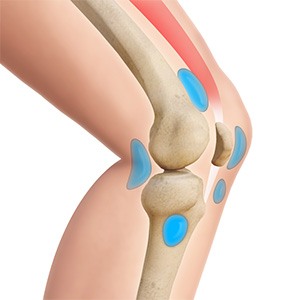Specialist Care for Knee Joint Bursa Infection in Ellsworth, ME
Fluid filled sacs called bursa can get infected in the knee joint causing pain, swelling and tenderness. Peter Copithorne, M.D. in Ellsworth, ME offers expert diagnosis and individualized non-operative and operative treatment plans for Knee Joint Bursa Infections. Peter Copithorne, M.D. also provides specialized care during and after surgery. To learn more about Knee Joint Bursa Infection, contact Peter Copithorne, M.D.office in Ellsworth, ME for an appointment today!

What is a Knee Joint Bursa Infection?
Knee joint bursa infection, also known as septic knee bursitis, is a condition characterized by inflammation of the small fluid-filled sacs (bursa) near the knee joint due to an infection caused by bacteria or other microorganisms. This occurs either on the kneecap, below the joint, or the inner side of the knee.
Causes of Knee Joint Bursa Infection
Causes of knee joint bursa infection include:
- Micro-organisms outside the body: The infectious micro-organisms may enter the knee joint bursa through cuts or scrapes on the surface of the knee. This is seen in people who spend a lot of time on their knees such as roofers, carpenters, plumbers, or athletes.
- Micro-organisms within the body: The infectious micro-organisms may be present in other parts of the body and travel through the bloodstream to enter the knee joint and bursa. This is seen in people with immunocompromised conditions.
Symptoms of Knee joint Bursa Infection
Signs and symptoms of a knee joint bursa infection develop slowly, worsen over time, and may vary based on the cause of the infection. They include:
- Pain
- Swelling
- Tenderness
- Stiffness
- Rashes on the skin
- Difficulty walking
- Difficulty moving the knee
Diagnosis of a Knee joint Bursa Infection
Diagnosis of a knee joint bursa infection involves:
- Physical examination: Your doctor will discuss your symptoms and examine your knee. If necessary, fluid from the bursa will also be aspirated and tested to confirm infection.
- X-rays: This will help detect any damage to the bone surface within the knee joint.
- MRI:This study uses magnets and strong radio waves to create images of the inflamed knee tissues.
- Ultrasound: This study uses sound waves to help visualize the bursa and nearby soft tissues.
Treatment for Knee joint Bursa Infection
Treatment is mainly focused on eradicating infection and relief of symptoms. Based on the severity of the condition, treatments may include:
- Medications: Your doctor may provide anti-inflammatory medications, corticosteroid injections, and antibiotic drugs to fight the infection.
- Bursectomy: This is the surgical removal of the infected bursa to prevent the spread of infection. This may be performed using minimally invasive techniques.
- Physical therapy: You will be instructed to carry out physical exercises to strengthen the knee muscles and improve flexibility.
Prevention for the Knee joint and Bursa Infection
Preventive measures include:
- Regular exercise to strengthen the knee muscles
- Use a knee pad when kneeling or applying pressure to the knee
- Maintain a healthy weight
If you would like to have additional information on the treatment of knee joint bursa infections, please contact Peter Copithorne, M.D.in Ellsworth, ME.








